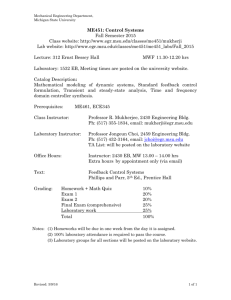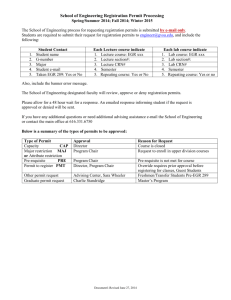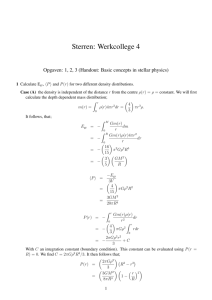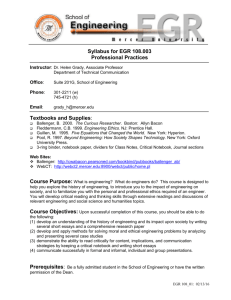An Introduction - College of Engineering and Computer Science
advertisement
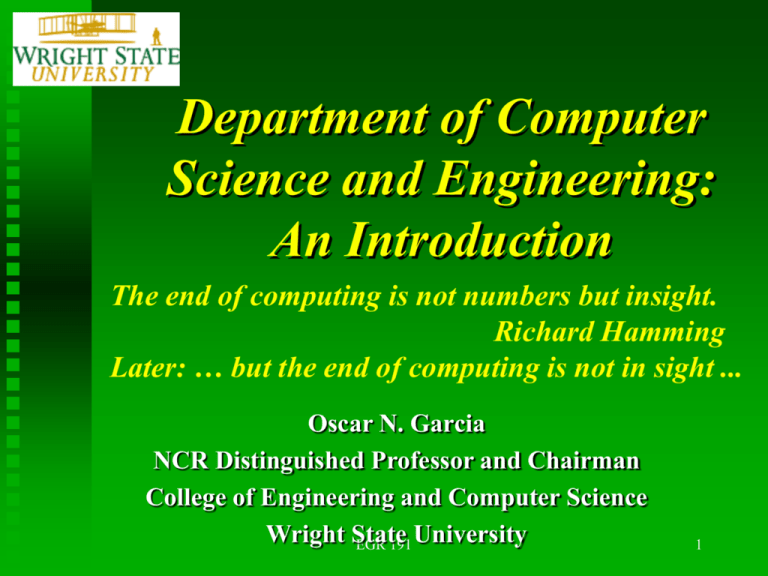
Department of Computer Science and Engineering: An Introduction The end of computing is not numbers but insight. Richard Hamming Later: … but the end of computing is not in sight ... Oscar N. Garcia NCR Distinguished Professor and Chairman College of Engineering and Computer Science Wright State EGR 191 University 1 Introduction An Introduction to the programs of the CS&E Department Admission, Administration and Advising CS and CEG: How are they alike? How are they different? An Overview of the Department Summary and Advice A Demonstration EGR 191 2 Admission to the College In general, when you come into WSU as a freshman, you are part of the University College which handles your advising and placement testing. There are two ways of being admitted to the College and to your program of preference: You complete 45 QH, keep a 2.25 QPA average on all courses and in all CS&E courses, C or better in all core courses (English, Math, Physics, CS) Your High School and SAT/ACT scores qualify you for Direct Admission to the College and program. EGR 191 3 CS&E First Year in College High School University College COECS Program Transfer Students Most of the time you take a year of Computer Science courses (CS240, 241,242), a year of Calculus (MTH229, 230,231), Intro. to Engn. (EGR 190, 191), English and Gen. Ed. Courses, and CEG255 for Computer Science majors or CEG 260 for Computer Engineering Majors. THERE ARE HELP ROOMS FOR MATH AND FOR INTRODUCTION TO COMPUTER SCIENCE (RC308) EGR 191 4 Department Programs At the Undergraduate Level BS in Computer Science (CSAB Accredited) 320 Students Options: CS, Business, Science, Bioinformatics TBA BS in Computer Engineering (ABET Accredited) 210 Students At the Graduate Level Master Degrees in Computer Science Master Degree in Computer Engineering PhD in Computer Science and Engineering EGR 191 5 The Computer Science and Engineering Department Administration Departmental Administration Offices: RC 303 Oscar N. Garcia, NCR Dist. Prof. and Chair Jay DeJongh, Assistant Chair Dan Spiegel, Curriculum Advisor who helps you with your Program of Study (POS) Staff Paula Price, Senior Secretary Jennifer Limoli, Secretary Valerie Smith, Secretary EGR 191 6 Mentors and Curriculum Advisor Once you are admitted to the College of Engineering and Computer Science and to the CS&E Department you are assigned a Mentor who is a faculty member in the Department on whom you can call for any non-program of study (POS) question. All POS questions are handled by Mr. Dan Spiegel by appointment in the Departmental office (RC303). A student-mentor list is posted across RC305 EGR 191 7 CS&E Department Faculty (could be your Mentors) Full Professors (3) Oscar Garcia (Chair), Philip Chen,Tom Sudkamp Associate Professors (9) Abdul Awwal, Soon Chung, Guozhu Dong, Ardeshir Goshtasby, Jack Jean, Prabhaker Mateti, T. K. Prasad, Francis Quek, Mateen Rizki, Assistant Professors (7) Wasfi Al-Khatib, Michael Cox, Travis Doom, John Gallagher, Michael Raymer, Ricardo Gutierrez, Bin Wang Instructors (4) and Lecturers*(2) Stephen Carl, Michael Findler, Robert Rea, Ron Taylor, Karen Meyer*, Dan Spiegel * EGR 191 8 Computer Science or Computer Engineering? Computer Scientists are interested in the computer as a logical machine that enables symbolic manipulation through programming and data transformations and analysis. Computer Engineers are interested in the economic design, reliability, reparability, and use of the physical machine, but must know CS. Both are concerned with the social and economic impacts of computing and with keeping up-to-date EGR via191life-long learning. 9 Brief Comparison between CS and CEG Total number of QHs: CS 192; CEG 196 Computer Science: 8 CS + 7 CEG courses Compute Engineering: 5 CS + 9 CEG CEG is somewhat related to EE and other engineering subjects; in CS there is more flexibility in the electives and may even include a Business or Science option (or a Bioinformatics option in the near future.) EGR 191 10 Computer Engineering Program Overview In addition to the “core courses”: CEG 402 Networks CEG 453 Computer System Design plus EE and ME courses such as ME 212-3 Statics and Dynamics EE 301-4 Circuit Analysis I and II and Labs EE 321-2 Linear Systems I and II EE 331-2 Electronic Devices and Lab and a few electives. EGR 191 11 Computer Science Program Overview In addition to the “core courses”: CEG 255 Introd. to Computer Info. Systems CS 405 Introd. to Data Base Management Syst. CS 466 Introd. to Formal Languages CS 480 Comparative Languages plus a wider range of electives and options in Business, Science, or other concentrations, and in Bioinformatics in the near future. EGR 191 12 Computational Processes Most frequently have been visualized as: Data or Sensor Input Processing or Logical Transformation Output or Robotic Actuator These processes have been classically considered as carried out by hardware and software under the control of operating systems that manage the access and flow of the information. EGR 191 13 The new IT world: distributed computation, databases and networking Logic Databases Machine Reasoning Searching DataWarehousing Datamining Human-Computer Interaction Web Programming Parallelism Video on Demand WWW Classical View Modern IT View EGR 191 14 Teaching and Research Labs RC025 - Neural Dynamics and Control Laboratory RC112 - Optical Computing Laboratory RC152A - PC Computing Laboratory RC263 - Supercomputing Laboratory (SGI and NCR) RC304 - Intelligent Systems Laboratory RC315 - Hardware Projects Laboratory RC339 - Microprocessor Design Laboratory RC346 - PC Networking Laboratory RC347 - HCI Research Laboratory RC348 - Vision Interface and Systems Laboratory RC355 - Digital Design Laboratory RC357 - Computer Networks Laboratory RC407 - Adaptive Vision Laboratory RC429 - Operating Systems and Internet Security RC444 - Collaboration and Cognition Laboratory RC445 - Parallel Computing Laboratory RC446 - Software Engineering and Database Laboratory RC448 - Pattern Analysis and Machine Intelligence Lab. EGR 191 15 SGI Origin 2000 Supercomputer (32 R12000, 300MHz ) Control 350 GB (fiber channel, I/O) Disk Cabinet (Partially Hidden) 2x16 Processor Cabinets (12 GB RAM) EGR 191 16 New Hardware, New Projects: NCR 4800 (2 nodes X 4 processors 500MHz P-III Xeon) RAID5 Disk 4 GB Array 200 GB RAM NT-based TOR 2.0 Database System EGR 191 17 SGI Onyx-2 Infinite Reality In Room RC347 8 R10,000 Parallel Processors each with 512 MB (4 GB total) connected to the Net as ITRIOnyx EGR 191 18 We are strong in Research In FY2000 the department received $5.3M in research grants from different agencies. In FY1999 the WSU CS&E department received more basic research grants and more per faculty dollars from NSF than any other public CS department in Ohio Advanced undergraduates participate in many of these research activities in their junior or senior years through REUs or Research Experiences for Undergraduates ITRI is closely associated with the Department. EGR 191 19 Areas of Research Interest Database and Knowledge-Based Systems Machine Intelligence, Intelligent Interfaces, and Neural Networks Hardware, Optical, and Network Systems Software Engn., Computer Graphics, and Visualization Parallel Computing and VLSI EGR 191 20 Selected Current Research Projects Human Computer Interaction Workbench FPGA Run-Time Reconfiguration OCARNet ATM Project Microphone Array Project MM Database Project Vision Project: Stereo Tracking and 3-D Capture with Laser Range EGR 191 21 To integrate multiple modalities in communications between humans and computers and between humans. Metallic Rear Projection Projection on two on Softboard and side-screens in Vertical Screen “control room” mode for 2 and 3-D Wooden Desktop Projection Area - On right: Camera for hand and face tracking EGR 191 Position and Motion Tracking using 8 Ascension Flock of Birds Sensors 22 Advice @ $0.00 Start the Day with a Smile! Keep your priorities in line, w/o contradictions Every day make a list of what you will do every hour during that day If you need help: NEITHER BE BASHFUL NOR WAIT TOO LONG TO ASK FOR IT! Live One Day at a Time Survive the This Year, the others will follow Good luck!!! EGR 191 23 Summary The Computer Science and Engineering Department at WSU is one of the leading (if not the leading) departments in the field in Ohio We are also a department that cares for its undergraduates, but the initiative to contact Mentors, the Curriculum Advisor and Help Rooms must rest with the student. Your department faculty and administration are willing and able to listen to anything you have to say anytime and help you if you ask. EGR 191 24


